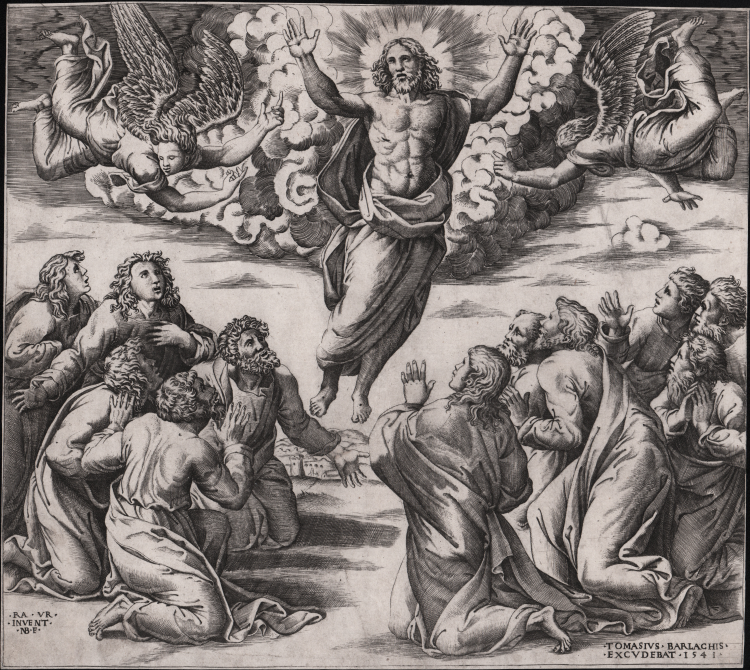




| Reference: | S32762 |
| Author | Nicolas Beatrizet detto BEATRICETTO |
| Year: | 1541 |
| Measures: | 310 x 284 mm |



| Reference: | S32762 |
| Author | Nicolas Beatrizet detto BEATRICETTO |
| Year: | 1541 |
| Measures: | 310 x 284 mm |
Engraving, 1541, lettered at lower left 'RA.VR. / INVENT / NB.F', at right 'Tomasius Barlachis / 1541'.
After Raphael.
First state, of three, with the monogram NBF and before the address of 'Ant. Lafrerij'.
A great impression, printed with tone on contemporary laid paper, trimmed to the paltemark, light paper folds on verso, otherwise very good conditions.
Bartsch thought it was after one of the Vatican tapestries.
The composition derives from a cartoon attributed to Raphael for the Arazzi della Scuola Nuova, with scenes from the life of Christ, designed for the rooms of the Concistorio.
Tommaso Barlacchi issued three engravings by Beatrizet: Joseph Explaining his Dreams to His Brothers; Ascension, and Christ in Limbo.
Very rare.
|
Bartsch XV.250.21; Passavant, II, p. 257; Zani, II, IX, p. 148; S. Bianchi, 'Catalogo dell'opera incisa di Nicola Beatrizet,' Grafica d'arte 14 (2003) 54, pp. 3-12; S. Massari, Raphael Invenit, p. 142, IX.
|
Nicolas Beatrizet detto BEATRICETTO Thionville 1515 circa - Roma 1565
|
Nicola or Niccolò Beatricetto, or Beatrice or Beatici or Beatricius or Nicolas Beatrizet Lotharingus according to the original name, was born in 1515 in Thionville, in the French region of Lorraine. He worked as drawer and engraver. He moved to Rome between 1532 and 1540 to study in the studio of Marcantonio and Agostino Veneziano. From the very beginning, he showed his peculiar sense of equilibrium for lines, shadows, tones and he became the leader of foreign engravers and artists in Rome. Under the influence of Agostino Veneziano and Giorgio Ghisi, Beatricetto picked up Raphael and Michelangelo as models for his work.
He worked for Salamanca (1540-1541), for Tommaso Barlacchi (1541-1550) and Lafrery (1548) who eventually added some of his work to his Speculum.
He essentially engraved reproductions of famous works, with sacred scenes and mythological subjects, buildings and palaces of his times. He died in Rome in 1565.
The states of the second half of XVI century bear the names of Claude Duchet and heirs, Paolo Graziani, Pietro dè Nobili; in the XVII century those of Giovanni Orlandi, Philippe Thomassin, Gio.Giacomo dè Rossi “alla pace” and Giovan battista dè Rossi “a piazza Navona”; in the XVIII century that of Carlo Losi.
Bartsch lists 108 prints under his name, Robert-Dumesnil 114 and Passavant 120.
|
|
Bartsch XV.250.21; Passavant, II, p. 257; Zani, II, IX, p. 148; S. Bianchi, 'Catalogo dell'opera incisa di Nicola Beatrizet,' Grafica d'arte 14 (2003) 54, pp. 3-12; S. Massari, Raphael Invenit, p. 142, IX.
|
Nicolas Beatrizet detto BEATRICETTO Thionville 1515 circa - Roma 1565
|
Nicola or Niccolò Beatricetto, or Beatrice or Beatici or Beatricius or Nicolas Beatrizet Lotharingus according to the original name, was born in 1515 in Thionville, in the French region of Lorraine. He worked as drawer and engraver. He moved to Rome between 1532 and 1540 to study in the studio of Marcantonio and Agostino Veneziano. From the very beginning, he showed his peculiar sense of equilibrium for lines, shadows, tones and he became the leader of foreign engravers and artists in Rome. Under the influence of Agostino Veneziano and Giorgio Ghisi, Beatricetto picked up Raphael and Michelangelo as models for his work.
He worked for Salamanca (1540-1541), for Tommaso Barlacchi (1541-1550) and Lafrery (1548) who eventually added some of his work to his Speculum.
He essentially engraved reproductions of famous works, with sacred scenes and mythological subjects, buildings and palaces of his times. He died in Rome in 1565.
The states of the second half of XVI century bear the names of Claude Duchet and heirs, Paolo Graziani, Pietro dè Nobili; in the XVII century those of Giovanni Orlandi, Philippe Thomassin, Gio.Giacomo dè Rossi “alla pace” and Giovan battista dè Rossi “a piazza Navona”; in the XVIII century that of Carlo Losi.
Bartsch lists 108 prints under his name, Robert-Dumesnil 114 and Passavant 120.
|